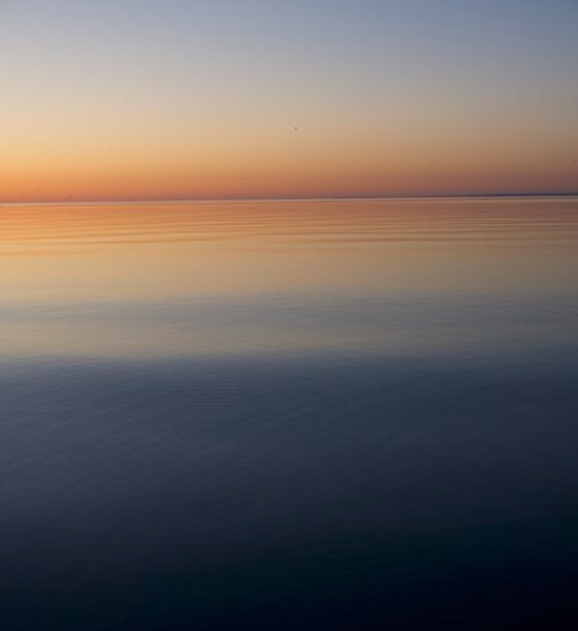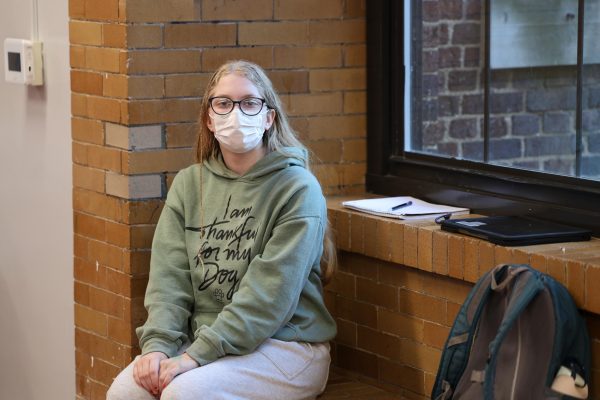Everything’s on the Line
The Great Lakes’ future appears murky amidst a litany of human and ecological threats. What’s to come for the world’s largest surface source of liquid freshwater?
Steve Coron, former CHS art teacher
Hot Dawn, Lake Superior
It was a Jamaican tour guide and his weathered glass-bottom boat that sparked the idea in Captain Jennifer Dowker that her childhood passion could become a bonafide career.
But the path to Dowker’s current success was rife with hardship; for months, she would lie awake at night researching business fundamentals, and by day Dowker crafted her business plan with her three sons as part of their homeschooling education. Her dream propelled her through a difficult period in her life: a tumultuous divorce.
In the fall of 2018, an opportunity to actualize her passion project arose: The Northern Lakes Economic Alliance, a nonprofit whose mission is to create jobs in four northern Michigan counties, invited Cheboygan County-area entrepreneurs to pitch their business plans for a chance at nearly $20,000 in startup funds. Dowker, banking on a victory at the Shark Tank-esque competition, was devastated when she did not attain any investment dollars.
“When we lost, I cried for two days straight,” Dowker said. “I didn’t know what I was going to do with my life or my career because I didn’t have much money at all.”
But after those two days of uncertainty, Dowker got a life-changing phone call. It was a private investor who had been in the audience a few days prior. He told her he thought she had what it would take to run a business and asked how much money she would need to begin.
The next summer, Nautical North Glass Bottom Boat Tours opened its doors.
Now, although Captain Dowker has paid her private investor back in full and looks forward to work every day, running a water quality-reliant business isn’t always smooth sailing. For decades, the Great Lakes have been haunted by an intensifying host of ecological threats, putting countless coastal communities and careers at risk. We’ve seen a glimpse of the potential future in recent years, when water levels fluctuated beyond standard levels, causing extreme erosion and even causing some homes to collapse into northern Michigan lakes.
Despite its fragile ecology, a huge swath of the American Midwest is among a grouping of regions described by environmentalists as “climate havens” – regions that, based on factors like latitude and surrounding bodies of water, are projected to avoid the worst effects of natural disasters going forward.
The theory of climate havens is paradoxical – in the process of a mass migration and its following population influx, the fragile states of these so-called sanctuaries will likely be thrown off-kilter.
In the event of a large-scale relocation, experts may have to decide how much growth areas will be able to accommodate.
“Some people would say we already have enough population here, and if we go higher, we’re going to put too much stress on the Great Lakes,” said Dave Dempsey, a Great Lakes conservation expert. “We’d be putting way more demand on our environment… we’ll need to think about the impact of growth and sprawl on rivers and streams and a lot of other things that I’m not sure we’re talking about enough right now.”
Dr. Gregory Dick, a University of Michigan (UM) professor of earth and environmental sciences, also expressed caution towards the effects of this phenomenon. He worries that climate migration will amplify existing environmental injustices like contaminant and byproduct-heavy copper mining techniques that further pad corporations’ pockets and lower quality of life for historically marginalized and underrepresented groups.
The way forward holds numerous logistical concerns as well, like how we can develop our drinking water infrastructure to support more people and how we can support the area’s nature in withstanding escalating pollutants. The environment could have a bit of leverage though; more residents translates to more tax revenue. If economic growth and development can be taken advantage of, funding can be funneled to restoration initiatives and more sustainable, equitable development.
In light of all these hurdles in getting people to water, the natural workaround would be getting Great Lakes water to faraway people. However, this isn’t logistically possible – no pipeline long enough would be financially feasible, nor would it be legal.
Currently, the Great Lakes Compact (GLC) prevents any water from being exported outside the Great Lakes Basin (the area of land that drains into the five lakes), not accounting for diversions that existed prior to the Compact’s initiation. The Compact took about a decade to finalize and required extraordinary bipartisan cooperation between the eight states that border the Great Lakes and the Canadian government. It’s withstood numerous grabs at exporting and diverting water domestically and internationally but has made a few select exceptions.
In 2008, two cities just about a mile outside the watershed, but within the county of Waukesha, Wisconsin, a county that straddles the basin’s topographical dividing line, requested use of Great Lakes Water. Their source of groundwater was becoming contaminated with naturally-occurring radium, prompting the U.S. Environmental Protection Agency (EPA) to order officials to find another source of drinking water. Ultimately, the cities petitioned for and were granted access to Lake Michigan water, so long as they return treated wastewater to the basin and meet stringent requirements for conservation and efficiency.
“Waukesha was a victory,” said Jennifer McKay, a Great Lakes policy expert and Michigan Environmental Council Board chair. “It was a logical, realistic solution that kept the Compact strong while providing a legal water supply to cities in Waukesha county, as long as it plays by the rules. Because of how regulated and technical the Waukesha exception is, I do not see the Compact being amended in any way moving forward.”
But while we in Michigan live encircled by an internationally coveted source of freshwater, the United States’ west has undergone a yo-yo-ing 20 years of drought, despite being responsible for a large percentage of US agriculture. California, most remarkably, grows over 11% of the country’s produce, including many crops that can’t be grown as effectively in any of the other contiguous 47 states.
Although there is a loophole in the Compact that allows Great Lakes water to be shipped outside the basin in containers of 5.7 gallons or less, none has been transported with the explicit goal of mitigating drought and supporting agriculture in the west.
“If we could only use materials from Michigan [to make consumer goods], you wouldn’t have calculators, you would be doing your math on an old wooden abacus, your only jewelry would be copper, and you would only have iron tools,” said Jenna Munson, a UM professor of earth and environmental sciences. “That’s all we have here. That’s it, but we’re very used to saying ‘I don’t have this or that, can we trade? That’s how we’re able to have the society that we have. I don’t want Great Lakes water going anywhere, but there is a very valid argument to be made saying that for the United States’ food security, especially going forward, Great Lakes water is going to be very important.”
For the time being though, unless the Great Lakes Compact is overturned, the lakewater will be used in the ways it has been since the Compact’s inception. According to McKay, this needs reevaluating.
While bottling does affect the areas surrounding the bottling site, it does not have a remarkable consequence on the wider Great Lakes or surrounding areas. Instead, thermoelectric cooling, agriculture, public water supply, and hydroelectric power production are more substantial withdrawals from the system. There isn’t concern surrounding water levels dropping; in fact, they are projected to rise in the coming decades as a result of climate change. To be better prepared to monitor fluctuations, McKay suggests a reassessment of how water withdrawals are evaluated, along with a mapping of all groundwater resources in Michigan.
Another result of climate change on the minds of Great Lakes experts are Harmful Algal Blooms (HABs). The blooms are caused by an influx of nutrients that occurs when fertilizer and livestock waste is washed into the water supply by runoff and rainfall.
While Great Lakes HABs were first identified on a large scale in Lake Erie — a 2014 bloom caused “do not drink” advisory in the city of Toledo, leaving residents without potable water for two consecutive days — they are now spreading to Lake Superior and inland lakes throughout Michigan. The phenomenon is catalyzed by a proliferation of zebra and quagga mussels that were introduced to the Great Lakes system via the St. Lawrence Seaway. The Seaway is a canal system that connected the Great Lakes – which had been isolated for nearly 10,000 years – to the Atlantic Ocean. The worldwide shipping vessels it permitted to travel throughout the Great Lakes brought with them economic growth and numerous unfamiliar organisms. These organisms, not ecologically destined to fit into the Great Lakes food web, are called invasive species.
The zebra and quagga mussels, for example, came in the ballast tanks of European ships. These mussels consume algae that is beneficial to the native ecosystem and spit out water dense with toxic cyanobacteria, a bacteria that often leads to HABs. Their lack of native predators is just one of the reasons they were able to spread throughout the Great Lakes so quickly.
There are many other invasive species that have been identified in the Great Lakes, including sea lamprey which, although being somewhat controlled now, devastated native fish populations when they first invaded. Without a place in the food web, invasive species such as sea lamprey have no natural predators, creating an easy opportunity to reproduce rapidly and beat endemic animals to food sources. Sea lamprey alone cost the federal government about $10 million annually to regulate.
That sum, though, hardly compares to the ultimate Great Lakes hazard.
Widely regarded as America’s most dangerous pipeline, Line 5 is a 645-mile long pipeline that ships petroleum and is owned by Enbridge, a Canadian company. Beginning in Superior, Wisconsin and ending in Sarnia, a city in Ontario, Canada, the pipeline transports nearly 23 million gallons of nonrenewable oils per day. It runs through the Straits of Mackinac, parallel to the Mackinac Bridge in one of Michigan’s tourism epicenters. Built in 1953, the piping is now 70 years old and has exceeded its intended lifespan by 20 years.
Experts’ consensus says that Line 5 is old and vulnerable. It’s a ticking time bomb, and it needs to be shut down. If the possibility of a rupture came to fruition, over $65 billion in Great Lakes reliant wages would be put in jeopardy, nearly 720 miles of Lakes Michigan and Huron’s shorelines would be polluted, and dozens of endangered species’ populations would be obliterated.
In 2010, a different Enbridge pipeline ruptured in Talmadge Creek, a tributary of the Kalamazoo River. Almost one million gallons of crude oil contaminated many miles of the river, along with its banks and wetlands. This catastrophe was just one of 173 reported “incidents” since 2002 – proof that Enbridge is historically negligent: proof that something’s got to give.
“There’s an existing pipeline that runs around the base of Lake Michigan from Minnesota all the way to Port Huron that could be used [instead of Line 5],” Dempsey said. “The long term answer [to the pipeline] though, is obviously to cut back on fossil fuels. That won’t happen overnight, but it can be done and we’re seeing it begin to happen. I think even Enbridge can see that over the next 20 years there’s going to be a huge drop in fossil fuel demand.”
Regardless of those two options, Enbridge’s proposed alternative is to bore a 20-foot-diameter tunnel under the Straits that would house a new pipeline. For the first five months of 2023, meetings will occur to discuss whether or not the underground tunnel is viable or necessary, though many state and private environmental protection groups’ assessments have revealed holes in Enbridge’s plans.
For Love Of Water (FLOW) is one of these groups. On their website, the organization says that there are, “critical deficiencies in the project’s construction permit application, its legal authorization, and … [due to] expected impacts to wetlands, bottomlands, and surface water, FLOW has deep concerns about the lack of public necessity for the project, which would worsen climate change and related impacts to the Great Lakes.”
And Line 5 has few actual benefits for the state of Michigan and its residents: less than ten percent of what it ships is used by the state, while it threatens water supply, tourism, economy and way of life for more than five million Michiganders.“Everything is at stake [with Line 5], Captain Dowker said. “Literally everything’s tied into money, and my business is no different as far as money is concerned. Although my business is a labor of love, the Great Lakes mean more to me than my business. For example, we scuba-dive shipwrecks out in Lake Michigan and Lake Huron, and nobody can even get into the water if it’s being polluted in that type of a devastating way.”
Just like Captain Dowker’s tumultuous journey, the coming years for the Great Lakes will hold assorted obstacles. To provoke and accompany a sweeping revolution of industry, environmental professionals and everyday people alike will be called on increasingly to preserve the Lakes’ depths and shores through targeted ecological advocacy and the general curbing of climate change.
“Our economy is based on products that are manufactured with toxins that are not designed to be properly disposed of, among other issues,” Dempsey said. “Ultimately, producers ought to be required to change their methods instead of putting the burden on the consumer to choose what’s right for the environment. That’s the kind of environmental revolution we’re going to achieve by changing our entire economic paradigm, and that’s a really, really big shift.”
And while the need for change always brings uncertainty, it carries promise, too. Promise that conservation can be effective.
“For a number of years, we’ve seen on-the-ground progress in restoring and protecting the Great Lakes through a program that’s called the Great Lakes Restoration Initiative (GLRI),” McKay said. “The Great Lakes still face many urgent problems though, so we can not take the vast resources of the Great Lakes for granted.”










